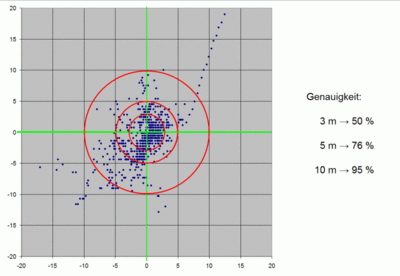Reliability of OSM coordinates
General
Reliability is a percentage that describes how often / how long a GPS-position is specified with the required accuracy.
The position accuracy of GPS-data is about 10m. That fits for 99% of the measurements. 50% of the measurements have an accuracy of about 2-5m, 1% of the measurements have a mistake in excess of 10m, always assumed optimal conditions. Between houses, in the forest or in the mountains the measurements are considerably worse. The center of the WGS84-ellipsoid lies in the geocenter, but only with a calculatory accuracy of ca. 5m, what additionally relativizes the accuracy of points.
The position accuracy of GPS-positions is dependent on many effects. Therefore it is important to increase the reliability of the determined position with multiple measurements.
Track-Bundle
If there are no satellite images then track-bundles are always needed for the illustration of courses of the roads. Only thus a sufficient shape accuracy can be achieved. In this example can be seen well that a single GPS-track follows the course of the road from good to not at all. Only with all tracks it is possible to map the course of the road.
Scatter-Plot
A single point can only be determined with multiple measurements as well. The measured point lies in the middle (intersection) of the scatter-plot.
Error Example
GPS is not an absolute measurement but only a preferably accurate estimate of the current position out of several derived indicators (pseudoranges). Our receivers only evaluate the L1 signal. Recievers that evaluate several signals (2 frequencies and also the phasing of the signal of a satellite) simultaneously are only used in surveying.
Imagine a measurement of a segment between two points with a calibrated measuring tape (in one piece) and a result of 10 meters. Then one thinks: the points have a distance of 10 meters. After that one takes the 20cm ruler out of the drawer and measures the distance again. And suddenly the result is 10.02m. Because one doubts (not measured exactly enough) one measures again: 9.98m etc. Several mappers get similar results with their rulers. Now if we measure often enough, maybe about 50 times, we will see that all results are round about 10m.
I. e. every single measurement severally is quite inaccurate (accuracy) and contains mistakes, but on average it fits quite well (reliability).
A reliable determination of the true length is only gained with the average of indipendent measures, that were all performed with similar accuracy.
- Transferred that means:
I leave with my GPS-reciever (ruler) and determine the position of a point and because I exert myself (exact feed, even segment ...) I am sure of hitting the correct position.
But tomorrow the next mapper comes with the same ambitions and is just as well sure of himself...
Conclusion for Good Reliability
To increase the reliability of the position of OSM-coordinates it is important to have many measurements (tracks). Therefore it is reasonable to share the own well-measured tracks with the other mappers. Otherwise there comes the situation again and again where a mapper believes to have measured the latest best track without the knowledge of other tracks and changes the position of an object by mischance.
In the meantime it is possible to upload GPX-data anonymously.
Also points need to be measured several times (scatter-plot).
Ideal is a combination of good aerial images and scatter-plots/line bundles.

